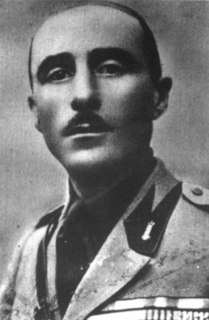Related Research Articles
The 1st CC.NN. Division "23 Marzo" was an Italian militia division, formed to participate in the Second Italo-Abyssinian War against Ethiopia in the mid-1930s.

The Militia Templi, also called the Order of the poor Knights of Christ, is a lay order of the Roman Catholic Church.

The Italian participation in the Eastern Front represented the military intervention of the Kingdom of Italy in the Operation Barbarossa, launched by Nazi Germany against the Soviet Union in 1941. The commitment to actively take part in the German offensive was decided by Benito Mussolini a few months before the beginning of the operation, when he became aware of Adolf Hitler's intention to invade, but it was confirmed only in the morning of 22 June 1941, as soon as the Italian dictator was informed that same day the German armies had given way to the invasion.

The 1st Infantry Regiment "Los Patricios" is the oldest and one of the most prestigious regiments of the Argentine Army. The title is often shortened to the Patricians' Regiment. Since the 1990s the regiment has been designated as air assault infantry. It is also the custodian of the Buenos Aires Cabildo, the welcoming party for visiting foreign dignitaries to Argentina and the escort, and honor guard battalion for the City Government of Buenos Aires. Since 22 September 2010, the Regiment's headquarters building has been a National Historical Monument following a declaration by the Argentine government on the occasion of the country's bicentennial year.

The Cannone da 70/15 was a mountain gun was used by Italy during World War I. By World War II it had been relegated to the infantry gun role in units assigned to Italian East Africa.

Ernest Peterlin was a Slovene military officer who rose to a senior position in the Royal Yugoslav Army prior to the Second World War. Married to Anja Roman Rezelj. A decided anti-Communist, during the war he became a prominent anti-Partisan military leader and one of the main exponents of the pro-Western faction of the Slovene Home Guard, an anti-Communist collaborationist militia active in parts of German-occupied Slovenia between 1943 and 1945. In 1945, he was tried and sentenced to death by the new Yugoslav Communist authorities and executed in 1946.

The Infantry Division "Friuli" was a division of the Italian Army active in World War II and during the early days of the Cold War.
Tullio Tamburini was an Italian soldier, adventurer and fascist official.
This is a list of words, terms, concepts, and slogans in the Italian language and Latin language which were specifically used in Fascist Italian monarchy and Italian Social Republic.
Anselmo Viviani was an Italian cross-country skier who competed in the 1930s and 1940s. In 1937, in the rank of an Alpino, together in team with Tenente Giuseppe Fabre and Sergente Luigi Perenni he won Gold at the Trofeo Mezzalama race. In the same year, he finished second in the 40 km event of the Italian men's championships of cross-country skiing.

The Siege of Roses or Siege of Rosas from 7 November to 5 December 1808 saw an Imperial French corps led by Laurent Gouvion Saint-Cyr invest a Catalan and Spanish garrison commanded by Peter O'Daly. After a siege lasting a month in which the haven and town of Roses was captured and the nearby Trinity Castle invested by over 13,000 French and Italian infantry, artillery and cavalry with heavy siege trains on the hills above, the Citadel was surrendered to the Napoleonic forces. Roses (Rosas) is located 43 kilometres (27 mi) northeast of Girona, Catalonia, Spain. The action occurred during the Peninsular War, part of the Napoleonic Wars.

The Royal Corps of Colonial Troops was a corps of the Italian Armed Forces, in which all the Italian colonial troops were grouped until the end of World War II in Africa.

The Voluntary Militia for National Security, commonly called the Blackshirts or squadristi, was originally the paramilitary wing of the National Fascist Party, known as the Squadrismo, and after 1923 an all-volunteer militia of the Kingdom of Italy under Fascist rule, similar to the SA. Its members were distinguished by their black uniforms and their loyalty to Benito Mussolini, the Duce (leader) of Fascism, to whom they swore an oath. The founders of the paramilitary groups were nationalist intellectuals, former army officers and young landowners opposing peasants' and country labourers' unions. Their methods became harsher as Mussolini's power grew, and they used violence and intimidation against Mussolini's opponents. In 1943, following the fall of the Fascist regime, the MVSN was integrated into the Royal Italian Army and disbanded.
The Comando unità forestali, ambientali e agroalimentari of the Carabinieri (CUFAA) is a specialized unit of the Italian Carabinieri force. Established on October 25, 2016, it has absorbed the personnel and functions of the State Forestry Corps from 1 January 2017.

The 7th Military Division was a regional army division of the Armistice Army, which in turn was part of Vichy France, a puppet state of Nazi Germany.

The Armistice Army was the common name for the armed forces of Vichy France permitted under the Armistice of 22 June 1940 after the French capitulation to Nazi Germany and Italy. It was officially disbanded in 1942 after the German invasion of the "Free Zone" which was directly ruled by the Vichy regime.
The Maritime Artillery Militia was an artillery unit of Italy's Milizia Volontaria per la Sicurezza Nazionale. It was active from 1939 to 6 December 1943.

Lorenzo "Renzo" Chierici was an Italian Fascist official, prefect and soldier, who served as Commander of the Forestry Militia from December 1941 to April 1943 and Chief of the Italian Police from April to July 1943.

Mario Balotta was an Italian general during World War II.

Enrico Francisci was an Italian general during World War II.
References
- 1 2 3 4 "Regio Esercito - MVSN - La Milizia Forestale". Regioesercito.it. Archived from the original on 2017-03-26. Retrieved 2021-08-23.
- ↑ "La Campagna in Jugoslavia del 1941". Xoomer.virgilio.it. Archived from the original on 2020-10-20. Retrieved 2021-08-23.
- ↑ "La 2ª Campagna in Grecia del 1941". Xoomer.virgilio.it. Archived from the original on 2020-09-01. Retrieved 2021-08-23.